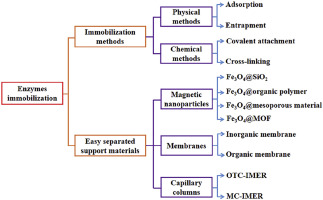Trends in Analytical Chemistry ( IF 11.8 ) Pub Date : 2018-03-21 , DOI: 10.1016/j.trac.2018.03.011 Dong-Mei Liu , Juan Chen , Yan-Ping Shi

|
Compared with free enzymes, immobilized enzymes are more robust and resistant to environmental changes. In addition, with enhanced stability, immobilized enzymes can be separated from the reaction mixture and used for repeated cycles. These advantages prompt their applications in various fields. This review outlines the existing methods and easy separated support materials for enzymes immobilization. After a brief introduction on the immobilized enzyme, the immobilization methods of adsorption, entrapment, covalent attachment and cross-linking are discussed. The emphasis is given on the easy separated support materials of magnetic nanoparticles (MNPs), membranes and capillary columns. An outlook on the immobilized enzyme is given at last.
中文翻译:

固定化酶的方法和易分离的支持材料的进展
与游离酶相比,固定化酶更坚固并且对环境变化具有抵抗力。另外,具有增强的稳定性,可以从反应混合物中分离固定的酶,并将其用于重复循环。这些优点促使其在各个领域中的应用。这篇综述概述了酶固定化的现有方法和易于分离的支持材料。在对固定化酶进行简要介绍之后,讨论了吸附,截留,共价连接和交联的固定化方法。重点放在容易分离的磁性纳米颗粒(MNP),膜和毛细管柱的支撑材料上。最后对固定化酶进行了展望。









































 京公网安备 11010802027423号
京公网安备 11010802027423号